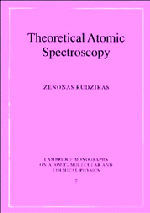Book contents
- Frontmatter
- Contents
- Preface
- Foreword to the Paperback Edition
- Introduction
- Part 1 Energy Spectrum of Many-electron Atom. Radiative and Autoionizing Transitions (Initial Formulas)
- Part 2 Foundations of the Angular Momentum Theory. Graphical Methods
- Part 3 Description of Complex Electronic Configurations
- 9 Non-relativistic and relativistic cases of a shell of equivalent electrons
- 10 Two and more shells of equivalent electrons
- 11 Classification of energy levels
- 12 Relations between various coupling schemes
- Part 4 Second-quantization in the Theory of an Atom. Quasispin and Isospin
- Part 5 Matrix Elements of the Energy Operator
- Part 6 Electric and Magnetic Multipole Transitions
- Part 7 Calculation of Energy Spectra and Electronic Transitions in the Case of Complex Configurations
- Epilogue
- References
- Index
12 - Relations between various coupling schemes
Published online by Cambridge University Press: 21 September 2009
- Frontmatter
- Contents
- Preface
- Foreword to the Paperback Edition
- Introduction
- Part 1 Energy Spectrum of Many-electron Atom. Radiative and Autoionizing Transitions (Initial Formulas)
- Part 2 Foundations of the Angular Momentum Theory. Graphical Methods
- Part 3 Description of Complex Electronic Configurations
- 9 Non-relativistic and relativistic cases of a shell of equivalent electrons
- 10 Two and more shells of equivalent electrons
- 11 Classification of energy levels
- 12 Relations between various coupling schemes
- Part 4 Second-quantization in the Theory of an Atom. Quasispin and Isospin
- Part 5 Matrix Elements of the Energy Operator
- Part 6 Electric and Magnetic Multipole Transitions
- Part 7 Calculation of Energy Spectra and Electronic Transitions in the Case of Complex Configurations
- Epilogue
- References
- Index
Summary
In the previous chapter we discussed the problem of classification of the energy levels of many-electron atoms using various coupling schemes, including intermediate ones. For this purpose we start with the coupling scheme closest to reality and optimize it. In practice this may be achieved in two different ways, namely, utilizing the expressions for matrix elements of the energy operator in a different pure coupling scheme with subsequent diagonalization of the energy matrices, or starting with the energy matrices in one definite coupling scheme, not necessarily supposed to be the closest to reality, with further use of the special transformation matrices, converting the wave functions of a given coupling scheme (including an intermediate one) to the other. These transformation matrices have to cover the cases of complex electronic configurations, consisting of several open shells.
Usually, the first way is utilized in practice. This is due to the well developed mathematical technique necessary, by the presence of the expressions for both the matrix elements of the energy operator and of the electronic transitions in various coupling schemes. However, the second method is much more universal and easier to apply, provided that there are known corresponding transformation matrices. Now we shall briefly describe this method.
Let |ψi) and |φj) denote two full orthonormal sets of wave functions, corresponding to a given energy spectrum of a definite many-electron system, classified with the aid of quantum numbers of two different coupling schemes. Let us suppose that these functions are non-relativistic, then they will have one and the same electronic configuration. In a relativistic case this transformation will couple different electronic configurations, and this coupling will be approximate.
- Type
- Chapter
- Information
- Theoretical Atomic Spectroscopy , pp. 97 - 106Publisher: Cambridge University PressPrint publication year: 1997



